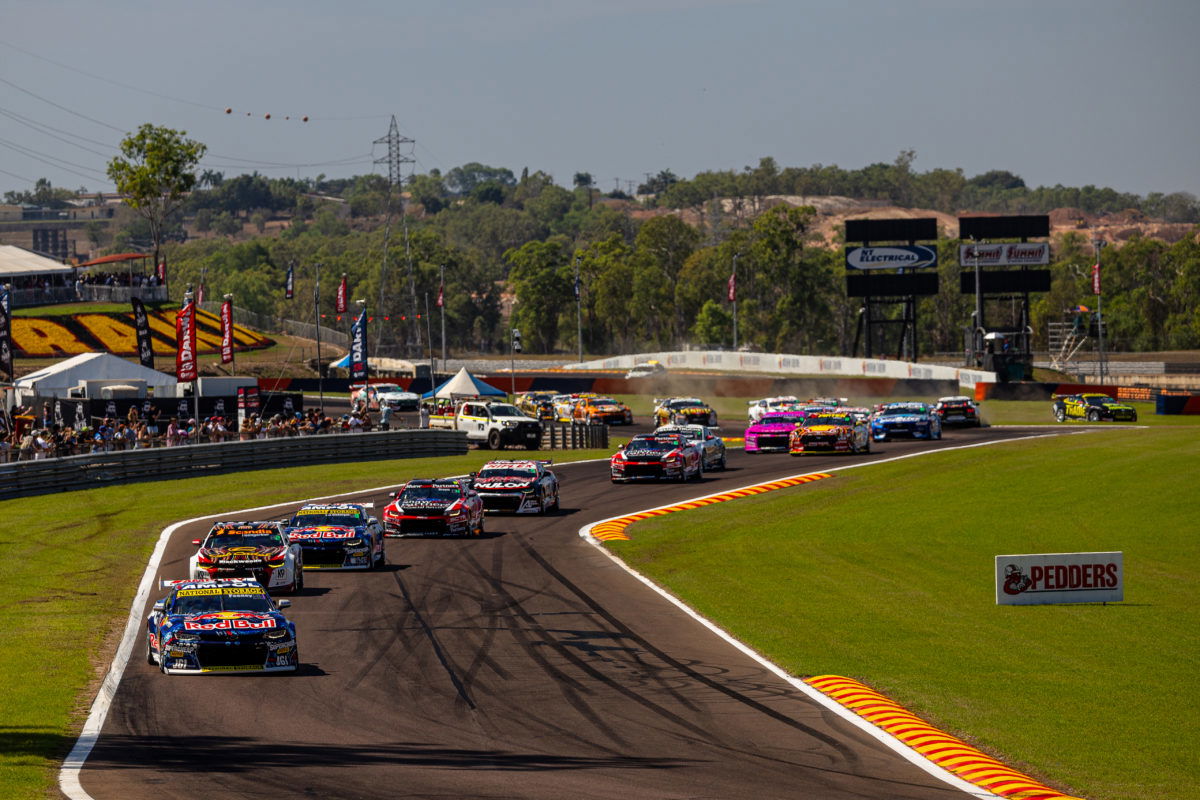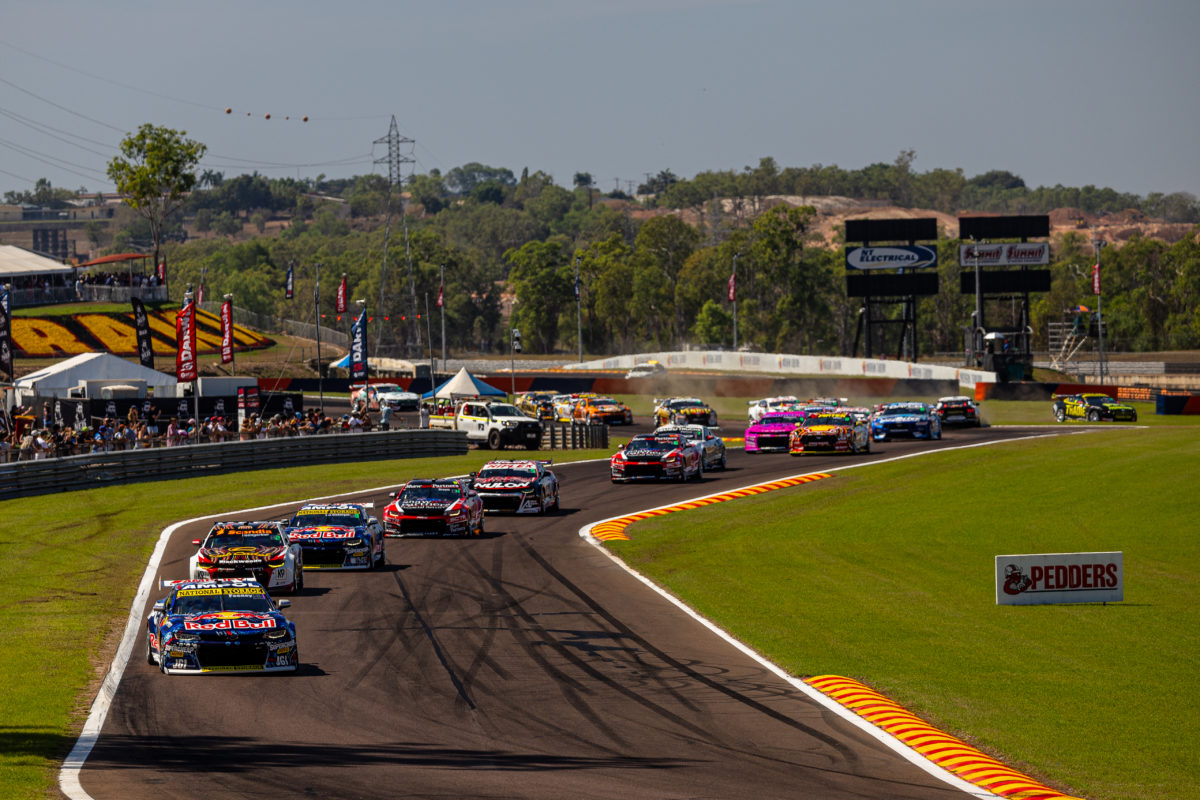

Just how many racing kilometres will the Repco Supercars Championship field clock up in 2024?
The perhaps surprising answer is that, despite the calendar remaining at just 12 events, and despite the move to a pair of timed races at SuperSprints (aside from Albert Park), there is likely to be more racing next year.
How much more is unknown at this point, with the four SuperSprints holding the key, but the net uplift looks to be a maximum of 140km.
The exact figure will depend on the length of the races at the Formula 1 Australian Grand Prix, and how fast the races at Wanneroo, Symmons Plains, and Hidden Valley turn out to be.
Those three circuits are critical to the question because their events will each see two, 60-minute races, rather than a trio of 100km encounters at a prescribed lap count.
While the speed of a race is partly a function of race pace, it will primarily be determined by whether or not there are Safety Car periods and, if so, how long they are.
Noting that the following analysis is based on the race lengths quoted in the 2023 Supercars Operations Manual, rather than the real-world figures once some races were cut short due to time-certainty, a total of 5360km of racing was scheduled this year.
Next year, the figure looks like being as much as 5500km, but would fall if Safety Cars appear during the six fully time-certain races.
For now, no schedule/race lengths have been announced for the AGP weekend but, with the same support bill as this year, we will assume for the purpose of the exercise that they are unchanged at 100km, 80km, 70km, and 70km respectively.
Obviously, not all of that racing was achieved this year because of late starts due to incidents in preceding sessions, and the Supercars field itself drawing Safety Cars, but using the same theoretical maximum race lengths provides a fair comparison (logic which applies to the other eight events which will have prescribed lap counts for each race).
Based on this year’s timesheets, there will be slightly fewer racing kilometres at Wanneroo and Hidden Valley than there were this year, but slightly more at Symmons Plains.
The winning time for last year’s three races at Wanneroo ranged from 39:51.3676s to 40:02.0953s for those 42-lappers.
Extrapolating that to a 60-minute window from the start of the formation lap (meaning 57 to 58 minutes of actual racing), we are looking at 60 to 61 laps without Safety Cars and thus an expectation of about 145km of driving in each race.
(Note that the calculation implicitly includes a pit stop in the average lap times, but average lap time would increase over a longer race anyway)
At Symmons Plains, where the 42-lap, 100km sprints lasted 37:15.6811s to 37:25.5847s, the figures are about 65 laps for a 60-minute race and thus about 155km of racing in each.
Hidden Valley, with a main straight which runs alongside a drag strip but also featuring plenty of corners, is the slowest of the three circuits in question.
Around 49 laps totalling about 140km are to be expected in each of its 60-minute races if they run Safety Car-free.
Two races in Darwin did indeed run green flag from start to finish, with the winning time being 40:40.6945s and 40:48.2781s, but the other saw two Safety Car periods totalling three laps and was won in 46:52.8384s.
If the latter figure was used in the calculations, the expected lap count would be around 43 and thus expected distance 125km.
What the calculations demonstrate is that the presence or otherwise of Safety Cars in Perth, Tasmania, and Darwin will play a big part in determining just how many racing kilometres are clocked up at those venues.
The other changes arise due to the formats of the Taupo and Sydney Motorsport Park weekends, namely ‘Super400’, comprised of a pair of 200km races.
Sydney last year saw a 200km race under lights and a 140km affair on the following Sunday afternoon, while Taupo effectively replaces The Bend, where a trio of 100km sprints were held in August.
Combined, those two circuits thus contribute an extra 160km of racing, whereas the three events with fully time-certain races look like knocking off at least 20km in total.
If, however, some of those races end up being demolition derbies, the total number of racing kilometres will end up being much closer to this year’s figure.
As for the Newcastle 500 being replaced by the Bathurst 500 as the season-opener, the former was also run as a pair of 250km races and hence there is no net change there.
The 2023 Supercars Championship concludes this weekend with a pair of 250km races at the Vailo Adelaide 500.
Race distance comparison: Supercars Championship, 2023 v 2024 seasons
| Race | 2023 event | Distance km* | 2024 event | Distance km** |
| 1 | Newcastle | 250 | Bathurst 500 | 250 |
| 2 | Newcastle | 250 | Bathurst 500 | 250 |
| 3 | Albert Park | 100 | Albert Park | 100 |
| 4 | Albert Park | 80 | Albert Park | 80 |
| 5 | Albert Park | 70 | Albert Park | 70 |
| 6 | Albert Park | 70 | Albert Park | 70 |
| 7 | Wanneroo | 100 | Taupo | 200 |
| 8 | Wanneroo | 100 | Taupo | 200 |
| 9 | Wanneroo | 100 | Wanneroo | 145 |
| 10 | Symmons Plains | 100 | Wanneroo | 145 |
| 11 | Symmons Plains | 100 | Hidden Valley | 140 |
| 12 | Symmons Plains | 100 | Hidden Valley | 140 |
| 13 | Hidden Valley | 100 | Townsville | 250 |
| 14 | Hidden Valley | 100 | Townsville | 250 |
| 15 | Hidden Valley | 100 | Sydney MP | 200 |
| 16 | Townsville | 250 | Sydney MP | 200 |
| 17 | Townsville | 250 | Symmons Plains | 155 |
| 18 | Sydney MP | 200 | Symmons Plains | 155 |
| 19 | Sydney MP | 140 | Sandown 500 | 500 |
| 20 | The Bend | 100 | Bathurst 1000 | 1000 |
| 21 | The Bend | 100 | Gold Coast | 250 |
| 22 | The Bend | 100 | Gold Coast | 250 |
| 23 | Sandown 500 | 500 | Adelaide | 250 |
| 24 | Bathurst 1000 | 1000 | Adelaide | 250 |
| 25 | Gold Coast | 250 | ||
| 26 | Gold Coast | 250 | ||
| 27 | Adelaide | 250 | ||
| 28 | Adelaide | 250 | ||
| Total | 5360 | 5500 |
* Per 2023 Operations Manual: Schedule A2
** Per 2024 calendar announcement and/or calculations outlined above




















Discussion about this post